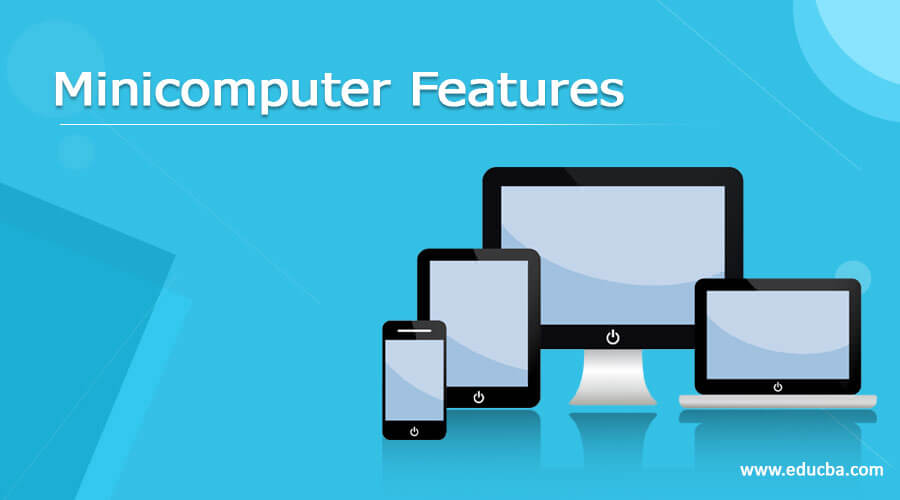Updated April 7, 2023

Introduction to Minicomputer Features
A Minicomputer is a computer that has many of the same features and functionality as a larger computer but is physically smaller. It is also known as Mini, as its name implies. It falls somewhere between a mainframe and a microcomputer in terms of computing systems, since it is smaller than a mainframe but larger than a microcomputer. The Minicomputer is smaller, cheaper, and less powerful than a mainframe or supercomputer, but more costly and powerful than a personal computer. In the mid-1960s, the Minicomputer was established, during that time, transistors and core memory technology were only used to construct small computers and IBM Corporation was the first to build them. Tablet PCs, Desktop minicomputers, mobile phones, laptops, high-end MP3 players, and so on are all examples of minicomputers.
Features of Minicomputer
The following are the features of the minicomputer –
It is relatively small in size of a mainframe computer – The minicomputer was developed as a result of the development of small process control computers. A minicomputer, such as the larger EDP computer system, has a central processing unit (CPU), memory, and a scientifically oriented instruction set and operates on a stored programme concept.
It is less costly than a supercomputer or a mainframe computer – Minicomputers were distinguished by their lower cost, applications, and the types of software packages that came with them when they were delivered. As the use of minicomputers has increased and memory costs have decreased, many minicomputer systems with more than 32,768 words of memory have become available.
It is not as powerful as a mainframe or a supercomputer, but it is much more powerful than microcomputers – Minicomputers are more powerful than personal computers, microcomputer and workstations, despite being smaller than mainframe or supercomputers, but it lacks the processing power of a mainframe or a supercomputer.
Multiprocessing and multitasking are supported – Minicomputers may have one or more processors, support multitasking and multiprocessing to perform several tasks at once, and are generally resistant to heavy workloads.
Small businesses and individuals may benefit from it – Some of the applications in the market served by smaller minicomputer systems are likely to be absorbed by the microcomputer, but in most cases, the microcomputer is finding application in completely new areas. The traditional minicomputer system has increased significantly in size, and it will become a more important competitor in the smaller business data processing applications.
Purpose of the Minicomputer
The primary purpose of the Minicomputer. They were primarily used for three purposes.
1. Controlling the Process
Minicomputers are mainly used by businesses to manage the production process. Data acquisition and feedback are the two main functions of Process Control. Minicomputers are used in factories to regulate the production process, for example. If an issue arises in some part of the method, it recognises it and makes the necessary changes.
2. Communication
Minicomputers serve as a link between a human operator and a more powerful processor. With the support of a minicomputer, the user may perform operations such as error checking and then use the system to make changes.
The following are some of the other applications –
- They are also used for scientific computations.
- Used to process company transactions.
- This program is used to handle databases.
- Used for engineering computations
- Used for file handling
3. Management of Data
Minicomputers, which we use for data management, can perform any data-related operation, such as taking, restoring, or generating data.
Applications of the Minicomputer
Here are some examples of minicomputer applications:
- It’s a term used in the field of business accounting.
- It is used as a sub computer of a mainframe computer; for example, it is used in a company’s sub-departments because it is less expensive than a mainframe computer.
- It is possible to assemble a group of minicomputers to form an internal network.
- Circulation, cataloguing, series control, management, acquisitions, correspondence, data retrieval, and so on are all done with it.
Conclusion
Minicomputers, also known as Minis, are a type of small computing unit. It was founded in the mid-sixties. It has many of the same features and functionality as a larger computer but is physically smaller. The Minicomputer is smaller, cheaper, and less powerful than a mainframe or supercomputer, but more powerful than personal computers, microcomputer, and workstations.
Recommended Articles
This is a guide to Minicomputer Features. Here we also discuss the introduction and features of the minicomputer along with its purpose and applications. You may also have a look at the following articles to learn more –

